
Dachshunds are part of the “Hound” group of dog breeds and are considered the smallest dog in this group. Dachshunds were bred to hunt burrowing animals (i.e. badgers, rabbits, and foxes) due to their long and short bodies. The name Dachshund stems from two German words conjoined that literally mean “badger dog.” These dogs are known for their lively, loyal, and friendly personality along with their keen sense of smell; as a result, according to AKC Registration Statistics, Dachshunds have become one of the most popular dog breeds adopted. A Dachshund’s coat will come in three varieties: longhaired, smooth, and wirehaired, while the color of their coat may be black, black and tan, black and cream, red, cream, chocolate and tan, and other color variations.
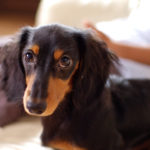
![]()
![]()
![]()
![]()
![]()
![]()
![]()
![]()
![]()
Did you Know?
- Dachshunds were bred to hunt small game animals that tunnel themselves into the ground. Packs of Dachshunds were actually used to track down and hunt wild boars that entered the land of their owners.
- Dachshunds’ devotion, friendliness, and versatility make them great family companions, however, their stubborn trait doesn’t always allow for easy housebreaking and crate-training is recommended.
- The body type of a Dachshund (beneficial to the purpose of their breed) can be detrimental to their health if owners allow them to become lazy, which will cause them to increase in weight, placing greater strain on their long, narrow, and fragile backs. Keep your Dachshund healthy and fit!
- A Dachshund’s playful spirit and intelligent mind tend to lead to mischievous and tenacious behaviors. They were bred to burrow after badgers, and their burrowing habit may lead them to dig out flower beds instead of badgers. Since they were bred to hunt, whatever is left on your home’s floor is fair game to them and they will treat it as prey. Long-haired Dachshunds were even used to hunt otters.
- A Dachshund’s bark is comparably deep and loud for their small stature, and they love to bark at strangers. They tend to be one-person dogs and will protect their companion with their loud bark and loyal spirit.
- A Dachshund’s long, narrow back often results in them experiencing a slipped disk, which may or may not cause partial or full paralysis. In light of this, it is highly recommended that you don’t let them jump from high places and make sure you support their backs when holding them.
Breed Characteristics
Adaptability

Adapts Well to Apartment Living: 5/5
Good for Novice Owners: 4/5
Sensitivity Level: 4/5
Tolerates Being Alone: 3/5
Tolerates Cold Weather: 1/5
Tolerates Hot Weather: 3/5
All-Around Friendliness

Affectionate with Family: 4/5
Incredibly Kid-Friendly Dogs: 5/5
Dog-Friendly: 3/5
Friendly Toward Strangers: 1/5
Health Grooming

Amount of Shedding: 3/5
Drooling Potential: 1/5
Easy to Groom: 3/5
General Health: 2/5
Potential for Weight Gain: 5/5
Size: 1/5
Trainability

Easy to Train: 2/5
Intelligence: 4/5
Potential for Mouthiness: 4/5
Prey Drive: 5/5
Tendency to Bark or Howl: 5/5
Wanderlust Potential: 5/5
Exercise Needs

Energy Level: 3/5
Intensity: 3/5
Exercise Needs: 3/5
Potential for Playfulness: 4/5
 History
History
Dachshunds are a German-bred dog that originally dates back to around the 15th century with illustrations that appear to depict this dog breed. There are other known documents using nicknames such as “badger creeper,” “earth dog,” “badger crawler,” and “badger catcher.” Badger Creeper is an obvious variation of the meaning of their name “badger (Dachs) dog (hund).” Badgers and other tunneling creatures were problematic, and in some areas still are. Dachshunds were the solution to this great vermin problem. The size of a Dachshund varied greatly, and their size and weight normally determined their hunting game. Dachshunds on the larger side (30 to 35 pounds) were used to burrow and hunt badgers and boars, while smaller Dachshunds (16-30 pounds) were used to hunt foxes and small deer. Smaller Dachshunds were used to hunt hares, weasels, and cottontails.
Other names these dogs are known by are Teckel and Dackel. In Germany, all Dachshunds are called Dackels, which most likely stems from the common German word ending “-el.” The name “Teckel” is often used among hunters and appears to be regional from different dog breed forums. Dachshunds were bred and fostered in order to develop a dog that could easily maneuver within a tunnel created by foxes, hares, and badgers. This meant hunters and foresters needed a dog that was sturdy, fearless, and with a a long, narrow body that wasn’t hindered in tunnels. There are differing opinions and resources that show alternative dog breeds that created the Dachshund. Smooth Dachshunds, the original, are said to have been bred from crossing a Braque (small French pointer) with a Pinscher (a terrier ratter). Long-haired Dachshunds are probably a cross breed from different spaniels, while the wire-hair Dachshunds are probably bred with terriers. Other sources specify that a Dachshund was probably bred from “schweisshund, a type of Bloodhound, pointer-type dogs known as dachsbracke, Basset Hounds, and Beagles.” (Source: http://www.vetstreet.com/dogs/dachshund#history)
Dachshunds are the only dog breed recognized by the AKC that hunts above and below ground. Important characteristics specific to their body type that make them excellent below-ground hunters are: short powerful legs, long sturdy tails extending from the spine, fearless and tenacious personalities, paws, smooth coat skin, deep chest for additional lung capacity, loud and deep barking.
Their short, yet powerful legs provided them with greater access and maneuverability within tunnels. Their paws attached to these powerful short legs were excellent for effective digging. Dachshunds’ long, sturdy tails made it possible for their human hunting companions to grab their tails and yank them from the burrow if needed. Their fearless and tenacious nature would allow them to fight to the death in the burrow if needed, and their smooth coats and skin made it possible for them to travel in burrows without tearing their skin. The additional lung capacity, due to their deep chest, allowed for greater stamina while hunting in tunnels, while their loud and deep bark make it possible for their human hunting companions to locate them.
The original Dachshund that hunted badgers were larger than the Dachshund we see as pets today, however, their current size doesn’t change their lively, tenacious, and fearless personalities at all. Their personality still shines bright even with the 5-pound bred Dachshunds to bolt out small cottontails in the brush. These dogs were bred to hunt and to kill their prey. Small toys offered to this dog do not stand a chance, especially if a “squeaker” is attached to the toy. They hunt. They pounce, and well– they destroy — so be careful not to leave any small “wanted” toys on the ground.
Their lively, loyal, and friendly personality attracted even royalty throughout Europe, and even Queen Victoria was fond of this dog breed. As this dog was desired more as a pet, the Dachshund gradually decreased in size since the 1800s. The original Dachshunds were around 30 to 35 pounds, and as the size was reduced the average weight is now about 10 pounds less, and like with some other dog breeds we now see “miniature” Dachshunds.
The year 1879 is an important year for Dachshunds as they were given a breed standard, by which in 1888 the German Dachshund Club was formed. Dachshunds arrived in America in the late 19th century, and at this time 11 Dachshunds were registered with the American Kennel Club (the first Dachshund was named Dash). In 1895, the Dachshund Club of America was founded. In America, this breed’s popularity increased in the early 1900s as they became one of the top dog breeds to be adopted, and were on the list of top 10 dog breeds entered into the Westminster Kennel Club Show. However, due to their German breeding, Dachshunds’ popularity decreased as a result of World War I. In the United States and England we have sad tales of Dachshunds being stoned as a result of their German ancestry, and their owners branded as traitors. These dogs went through similar treatment (although not as harsh) during World War II. Fortunately, this breed didn’t go extinct, and with time the Dachshund was once again a popular breed of dog to be adopted. In fact, in the 1950s Dachshunds became one of the most popular breeds to adopt as a family pet, and their status hasn’t fallen since. They are ranked by the AKC within the top 10 of hunting dogs even though they are rarely, if ever, used for hunting.
Size
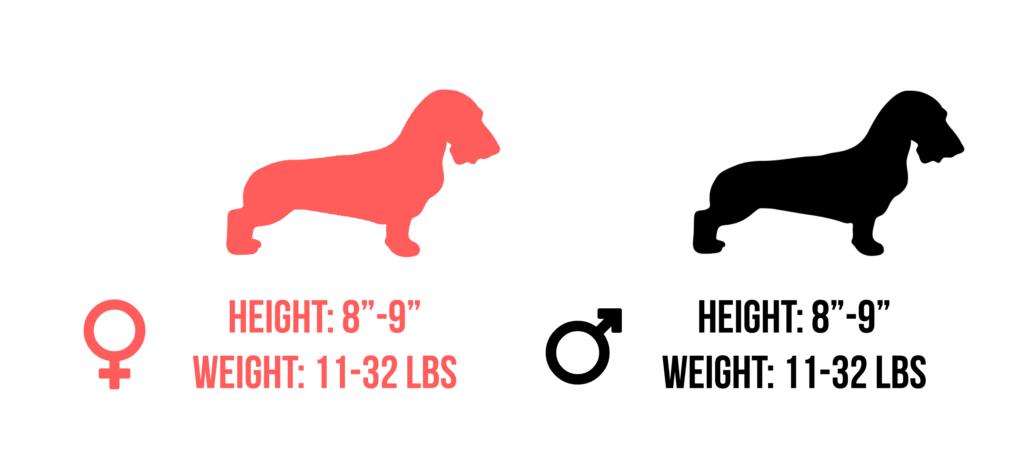 Smooth, wirehair, or longhair Dachshunds will weight between 5 to 32 pounds and will be classified as one of two sizes: Standard or Miniature. A standard size Dachshund will weight between 16 to 32 pounds, while a miniature Dachshund will weigh less than 11 pounds as a fully mature adult dog. The nickname “Tweenies” for Dachshunds are given to these dogs that weight between 11 and 16 pounds, and is not an official classification of this dog breed. Another non-official classification of this dog (often seen in advertisements) is “toy Dachshunds.” A toy Dachshund is a miniature Dachshund that is bred small and is not recognized by the AKC as a separate classification.
Smooth, wirehair, or longhair Dachshunds will weight between 5 to 32 pounds and will be classified as one of two sizes: Standard or Miniature. A standard size Dachshund will weight between 16 to 32 pounds, while a miniature Dachshund will weigh less than 11 pounds as a fully mature adult dog. The nickname “Tweenies” for Dachshunds are given to these dogs that weight between 11 and 16 pounds, and is not an official classification of this dog breed. Another non-official classification of this dog (often seen in advertisements) is “toy Dachshunds.” A toy Dachshund is a miniature Dachshund that is bred small and is not recognized by the AKC as a separate classification.
Appearance
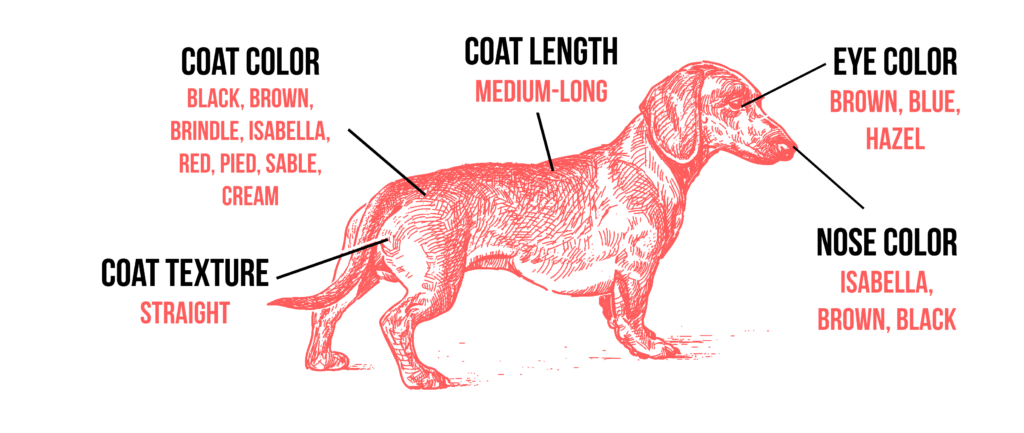 The most striking physical trait of the Dachshund is their long body that is low to the ground, with short legs. Their skin is pliable and elastic showing their muscular body. Despite their short legs and elongated bodies, they are very capable and fast moving dogs. After all, they were bred to hunt. Their coat can be long or short. Dachshunds can have a smooth coat that is silky and soft, and many of these Dachshunds are red or cream, and part-colored. Part-colored Dachshunds can be black, chocolate, wild boar (grizzled), gray (blue) or Isabella (fawn) with tan or cream markings. Wire-haired Dachshunds have a thicker coat that is wirey to the touch with a soft undercoat with the most common color being the wild boar. Long-haired Dachshunds have long wavy hair that is silky and typically come in the same colors as the smooth-haired Dachshund.
The most striking physical trait of the Dachshund is their long body that is low to the ground, with short legs. Their skin is pliable and elastic showing their muscular body. Despite their short legs and elongated bodies, they are very capable and fast moving dogs. After all, they were bred to hunt. Their coat can be long or short. Dachshunds can have a smooth coat that is silky and soft, and many of these Dachshunds are red or cream, and part-colored. Part-colored Dachshunds can be black, chocolate, wild boar (grizzled), gray (blue) or Isabella (fawn) with tan or cream markings. Wire-haired Dachshunds have a thicker coat that is wirey to the touch with a soft undercoat with the most common color being the wild boar. Long-haired Dachshunds have long wavy hair that is silky and typically come in the same colors as the smooth-haired Dachshund.
Behavior
Personality
Dachshunds are lively, friendly, courageous, and loyal companion dogs, and what they want most is to cuddle with their human companion. He is also clever, stubborn, fearless, entertaining, and can also be very rash. As these dogs have been bred from crossing different dog breeds, the type of coat they have may vary their personality. The Smooth Dachshund will often have a temperament in-between calm, quiet, and mischievous, while the wirehair Dachshund will often be more mischievous due to the terrier ancestry. Longhair Dachshunds are often more calm and quiet. In some cases, miniature Dachshunds may show characteristics of being shy and nervous, and if so, it is recommended to avoid puppies that lean toward this personality.
The personality and temperament of a Dachshund will be affected by their heredity, socialization, and training. Dackel pups that are playful, curious, and are approachable and willing to approach people have nice temperaments. Puppies with nice temperaments will not be the ones beating on other littermates, nor will they be the shy, unapproachable puppy that is hiding in the corner. If you are looking to adopt a puppy make sure you meet one of the parents to determine possible temperament. The mother is often the parent you will meet, and if you are able to meet relatives or siblings of the parents that is also a great way to evaluate the possible temperament of the litter and what they might be like as they become adult dogs.
Early exposure to different experiences, peoples, sights, and sound as puppies will benefit their temperaments. These efforts will help socialize your Dachshund to become more well-rounded while they are still puppies. Owners are able to socialize their puppy through kindergarten classes for dogs, taking them to stores that allow pets, allowing them to enjoy a walk in a busy park, having new visitors over regularly, and even taking them on leisurely walks will polish their social skills.
Children And Other Pets
If children are introduced to Dachshunds early then they are good with their own family, however, it would be wise to supervise playtime with your children’s friends who may come over until your Dachshund is familiar with them. It is good practice to maintain supervision if any children are near your dog.
The long backs of Dachshunds may cause injury to them if they are not handled properly. If there are young children present, teach them proper methods of approaching and touching dogs. Supervise children’s interactions with the dog to prevent any possible biting, pulling of ears and tails, or any mishandling of your dog. Children should be taught to never try to take away the dog’s food while they are eating to prevent nipping or biting from your dog.
As with other dogs, if introduced early Dachshunds will get along with other pets, and don’t be surprised if they try to be the top dog in the house with their bold, lively, courageous, and domineering personality.
Health
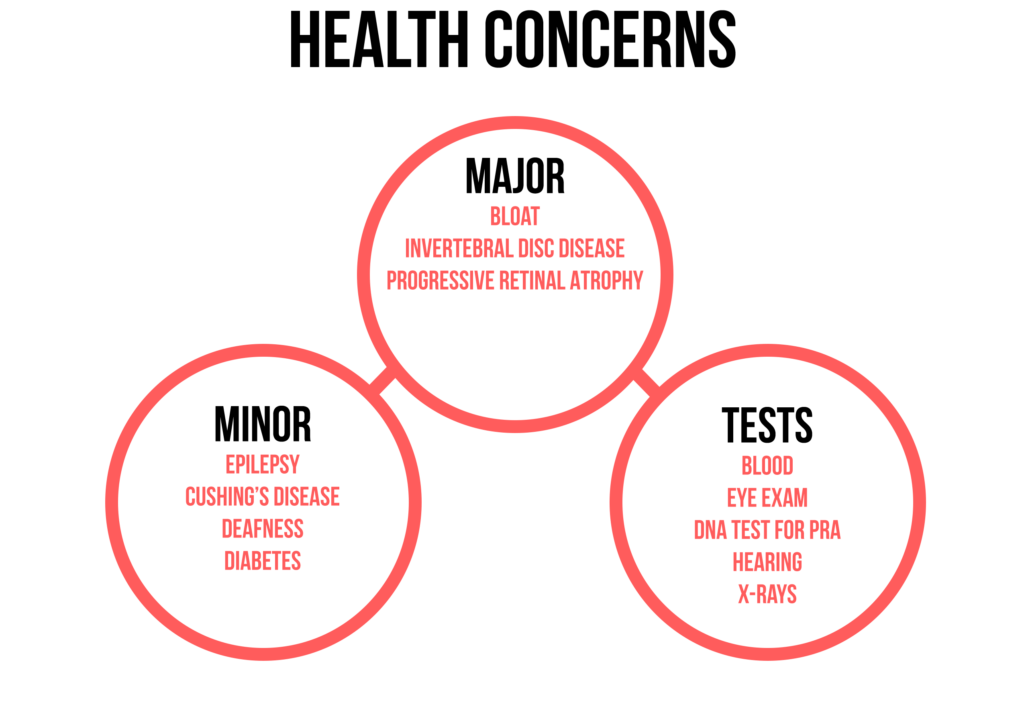 Dachshunds are generally a fairly healthy breed but as with all breeds, there are some health conditions they are more prone to. They do not have any major health problems but can be born with medical conditions or acquire conditions as they age. It is important to note that not all Dachshunds will have any or all of these conditions but it is good to be aware of possible health conditions they may have. If you have access to your dog’s parental health records that would be a great place to do some research and see what he may be prone to having. You can obtain health clearances for both of the parents of your dog to make sure they’ve been tested and cleared from the following conditions. Health clearances can be confirmed by checking the Orthopedic Foundation for Animals (OFA) website. Be sure to purchase from a responsible breeder that tests for health conditions in all the dogs they breed and provide vaccines and deworming prior to taking him home.
Dachshunds are generally a fairly healthy breed but as with all breeds, there are some health conditions they are more prone to. They do not have any major health problems but can be born with medical conditions or acquire conditions as they age. It is important to note that not all Dachshunds will have any or all of these conditions but it is good to be aware of possible health conditions they may have. If you have access to your dog’s parental health records that would be a great place to do some research and see what he may be prone to having. You can obtain health clearances for both of the parents of your dog to make sure they’ve been tested and cleared from the following conditions. Health clearances can be confirmed by checking the Orthopedic Foundation for Animals (OFA) website. Be sure to purchase from a responsible breeder that tests for health conditions in all the dogs they breed and provide vaccines and deworming prior to taking him home.
Intervertebral Disc Disease (IVDD)
Dachshunds have a high risk for IVDD. This is a condition where the cushioning discs between the vertebrae of the spinal column either bulge or burst (herniate) into the spinal cord space. This can be caused by trauma, age, or simply from the physical jolt that occurs when a dog jumps off a couch. The bulging (or burst) discs then press on the nerves running through the spinal cord causing pain, nerve damage, and even paralysis.
Treatment usually involves nonsteroidal anti-inflammatory drugs (NSAIDS) made especially for dogs. DO NOT give your dog Tylenol or other NSAIDS made for humans—they can be toxic. Surgery can be helpful in some cases if performed within a day or two of the injury. Ask your veterinarian if treatments such as massage, water treadmills, and electrical stimulation are available for dogs, as they can be very successful.
Progressive retinal atrophy (PRA)
Due to a loss of photoreceptors in the back of the eye, dogs suffering from progressive retinal atrophy will eventually become blind. This degenerative eye disorder can be caught early, even years before symptoms show, which can serve as a preparation for both dog and owner. Dogs will use their other senses to compensate for their vision loss and can continue to have an otherwise healthy and happy life.
Gastric dilatation-volvulus (GDV)
One of the more serious conditions your Dachshund may suffer from is gastric dilatation and volvulus, or “bloat.” This condition particularly affects large, deep-chested dogs (like Golden Retrievers) and is life-threatening, so it should be taken seriously. When a dog suffers from bloat, their stomach becomes distended with air or gas and then twists, making it impossible for the dog to belch or vomit to rid itself of any excess air or gas. Blood is impeded from returning normally to the heart, blood pressure drops and the dog goes into shock.
In such condition, immediate medical attention is needed to prevent your dog from dying. Bloat may occur if your dog is fed one large meal a day, eats rapidly, drinks large amounts of water after eating, and exercises strenuously after eating. Keep an eye on your dog if you notice they are salivating excessively and are trying to vomit but can’t. Other signs may include restlessness, depression, lethargy, and weakness with a rapid heart rate. If you notice your dog suffers from any of these symptoms, consult a veterinarian immediately.
Cushings Disease (Hyperadrenocorticism)
This disease happens when the dog’s body produces an excessive amount of the hormone called cortisol. Excessive amounts of cortisol may result from the imbalance in the pituitary gland, the adrenal gland, or from other conditions that occur within the dog to increase cortisol levels. What should you be aware of in order to identify “Hyperadrenocorticism” disease? If your dog is urinating and drinking excessively, then take him to see your local vet; fortunately, there are procedures and surgeries that will treat this disease.
Canine Diabetes Mellitus (DM)
Although not as common, Dachshunds that tend to be diagnosed with Canine Diabetes Mellitus are overweight. Standard treatments for dogs with DM are watching diet and if needed, daily insulin injections. If your dog begins to urinate excessively, thirst more often, and experience weight loss even while maintaining a healthy diet these are signs that they may need to be checked for Canine Diabetes Mellitus.
Deafness
Unfortunately, it’s fairly common for Dachsunds to suffer from deafness. Whether the condition can be treated medically or surgically depends on the form of deafness your dog suffers from, but usually, there is no cure for it. To make life easier for both dog and owner, there are various products on the market that can be put to use such as vibrating collars. If you find out your dog will suffer from deafness, make sure you evaluate your Aussie’s need and if you will be able to take care of it.
When adopting any puppy, good breeders will have records from both parents regarding health clearances, which prove the dog has been tested and cleared of known health conditions. If your Dachshund has tested and cleared, then you should see a health clearance from the Canine Eye Registry Foundation (CERF) certifying the eyes of your Dachshund are normal.
Dogs that are under 2 years of age are not issued any health clearances as specific conditions and disease do not appear until a dog reaches full maturity. This is why it has been recommended that dogs are not bred until they have reached 2 years of age or older.
Maintenance
 Care
Care
Dachshunds enjoy taking walks, playing outdoors, hunting, digging, and they also enjoy a moderate amount of daily exercise due to the amount of energy and stamina they have. If their living quarters are smaller, then taking these dogs on daily exercise will be beneficial to their health. It is recommended that they are taken on daily walks for about 3 miles or a little less. This amounts to around 30 minutes daily. If you don’t have enough time in a day to take your Dachshund for a walk, then a good rigorous play of fetch will meet their need for exercise.
Dachshunds may be able to live outdoors or in kennels, although, it is highly recommended that they live in the house. As their bodies are elongated with shorter legs they can easily injure themselves when jumping on or off furniture. In order to prevent potential back issues, we recommend getting a ramp that your dog can be trained to use instead of jumping on or off your furniture. When holding a Dachshund, make sure you securely have their chest and rear supported.
Dachshunds, if properly motivated, are able to learn new tricks quickly through methods of positive reinforcement in their training. Food and their favorite toys are often excellent methods to keep their attention and to properly motivate, however, if the method becomes too repetitive Dachshunds will become bored, so make sure the activities you are using to train your dog are fun and entertaining.
Dackels are not easily house-trained, therefore teaching theme to relieve themselves outside may be difficult. House training will require patience and consistent efforts that allow your dog to properly learn where to eliminate their waste. Crate training may also be helpful with this breed.
The benefit of crate training is the ability to ensure your Dachshund does not do anything he shouldn’t, as they can be very destructive when they are puppies (similar to other dog breeds’ puppies). Another benefit of crate training is that your dog will become accustomed to the crate when needing to board or hospitalize your dog. The crate, however, is not a place where your dog should be confined to all day. If your dog is crated during the day it should only be for short periods of time. As other dogs, Dachshunds are friendly and people dogs and should not be locked in a crate or kennel for an extended period of time. They want to roam, and they want to be with their human companions.
Dachshunds have been known to be excellent watchdogs as they are wary of strangers, and they will warn their human companions of intruders. However, they can be very noisy and yappy, which is common with miniature dog breeds. This is important should you live in a condo or apartment complex.
Feeding
As with any dog, purchase high quality, nutrient dense dog food. Ask your veterinarian what food blend would be best suited for your dog. Factors such as age, size, activity level will make a difference on what kind of food he needs and how much. Typically, Dachshunds will need ½ cup to 1½ cup of dry food a day. It is recommended that this amount be divided into two separate meals, one in the morning and one at night.
Grooming
The fact that Dachshunds require less maintenance is a positive for this breed. They do not require constant bathing as they are normally free from doggie odor unless, of course, they have rolled into something that smells bad. Dachshunds with a smooth coat generally can be cleaned with a damp cloth in order to keep them clean. If the weather is a colder temperature during the fall and winter months you may want to dress them in a doggie sweater to keep them warmer when you go out on walks. Pet stores now have a good number of clothes for owners to choose from to help maintain their Dachshunds warm during colder weather.
A wire-haired Dachshund will require a little more grooming. Their coats will need regular brushing and they will need to be “stripped” a few times throughout the year to keep their coat looking clean. If you don’t want to take your Dachshund in every time it needs to be stripped, you can contact your breeder or your local vet to properly show you how to perform this.
A long-haired Dachshund will require more grooming than a wirehaired Dachshund in order to keep their coat from matting. They also will require more bathing than the other two types of Dachshunds, and after a bath, their coat will need to be dried thoroughly (better if blow-dried) to keep their coat looking good.
When you are grooming, brushing your Dachshund, pay close attention to possible fungus, bacteria, or mites that might be growing around their droopy ears. It is recommended that you wipe their ears weekly with a moistened cotton ball of ear cleaner that has been recommended by your veterinarian. This will help prevent any harmful bacteria, mites, or fungus that might cause issues for your dog. When cleaning their ears make sure you don’t go any deeper than needed, and that you do not ever stick cotton swabs inside your Dachshund’s ears.
Other grooming tips include trimming their nails about once a month and checking their ears once a week (for dirt, redness, or bad odor, which might indicate an infection). When cleaning their ears, wipe them with a cotton ball that’s been dampened with a gentle, pH-balanced ear cleaner. Since they love to chew, it’s probably a good idea to buy them sturdy, safe dental chew toys or bones, as this will keep their teeth clean and they’ll be fighting tartar buildup while they chew.
Additional things that you can do to maintain their mouth care is to brush their teeth with a soft toothbrush and specially made dog toothpaste. This will help keep their gums and teeth in great shape.
Questions
Are Dachshunds good pets?
Dachshunds make a loyal family pet and will be good with children if they are good with him. They can be a bit difficult to train, and some breeders note personality differences in different types of Dachshunds.
Do Dachshunds shed a lot?
All three coat types of Dachshunds shed. This can be maintained by brushing them weekly.
Why do Dachshunds like to sleep under the covers?
Remember they were bred to flush prey out of burrows, it is in their blood to enjoy being in a sort of “den.” Being under the covers is a way they feel safe and warm.
What is the average lifespan of a Dachshund?
The average Dachshund lives between 12 to 15 years.
Can Dachshunds swim?
They can be taught to swim, but remember, due to the size of their legs they are not strong swimmers. They prefer land activities.
Resources
Unfortunately, not everyone that purchases a Dachshund fully understands everything that goes into raising and training a well behaved, healthy Dachshund. There are many Dachshunds in need of a loving home whether that be through adoption or fostering. Below is a list of Rescue agencies that have Dachshund. If you do not see a local rescue below you can contact a local or nation Dachshund Breed Club and ask them.
Rescue
Breeders
- Dachshund Dogs & Puppies – Puppyspot.com
- Welcome To Heartfelt Dachshunds! | Heartfelt Dachshunds
- Dachshund Puppies For Sale – AKC PuppyFinder
- Welcome to Guntner’s Dachshunds
- Dachshund Puppies for Sale from Reputable Dog Breeders
Dachshund Adults For Sale
If you’re interested in purchasing adult Dachshunds, click on the links below to find what you’re looking for.
Dachshund Puppies For Sale
If you’re interested in purchasing Dachshund puppies, below you will find different online marketplaces that have Dachshund puppies for sale.
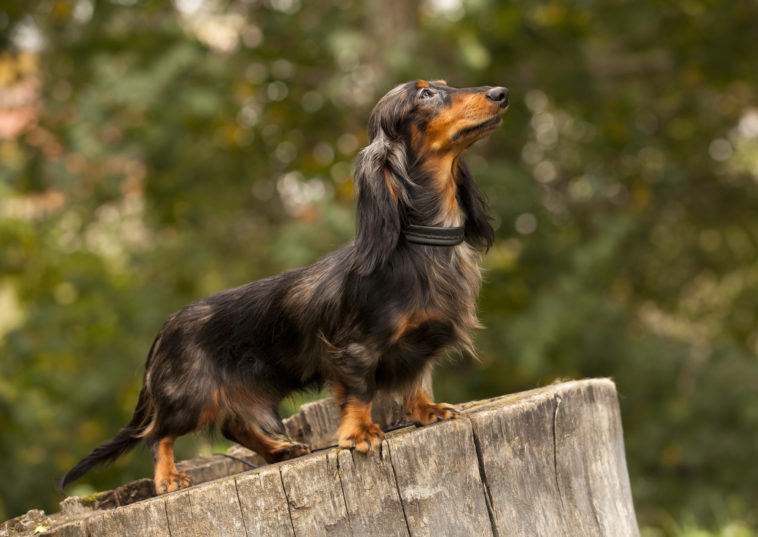
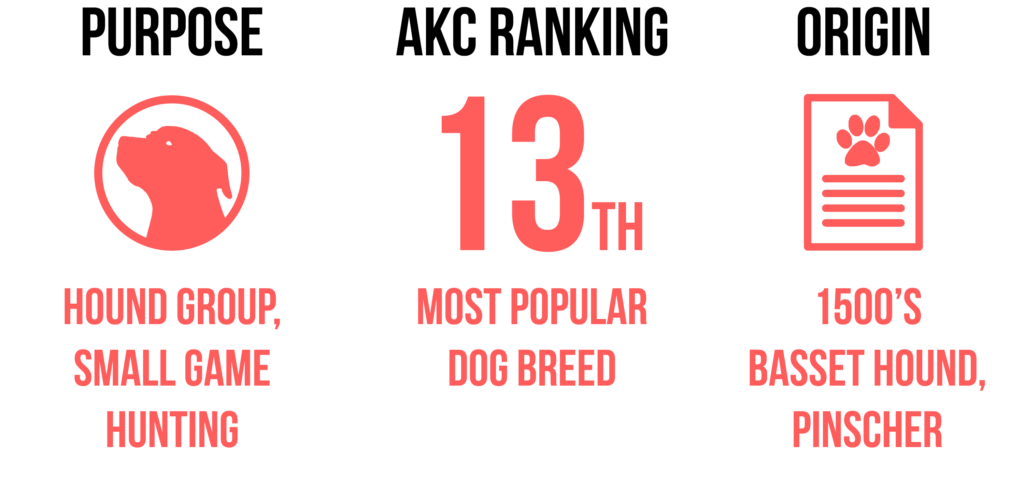 History
History Care
Care